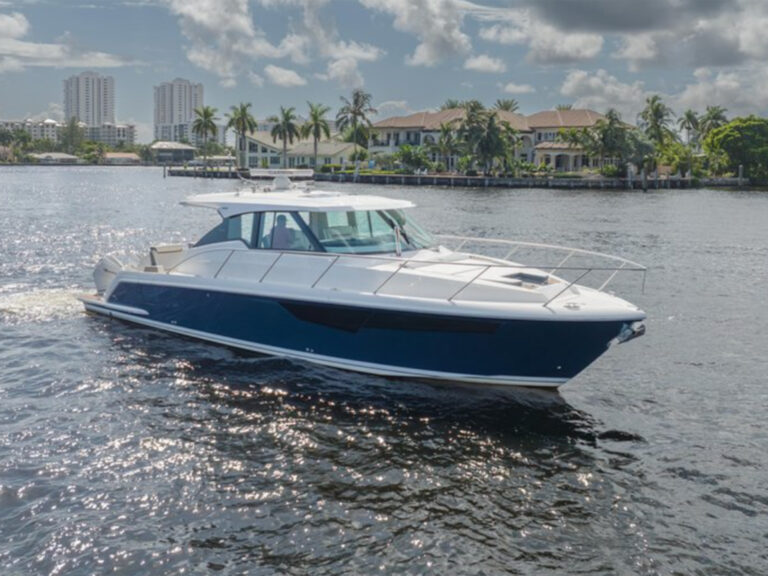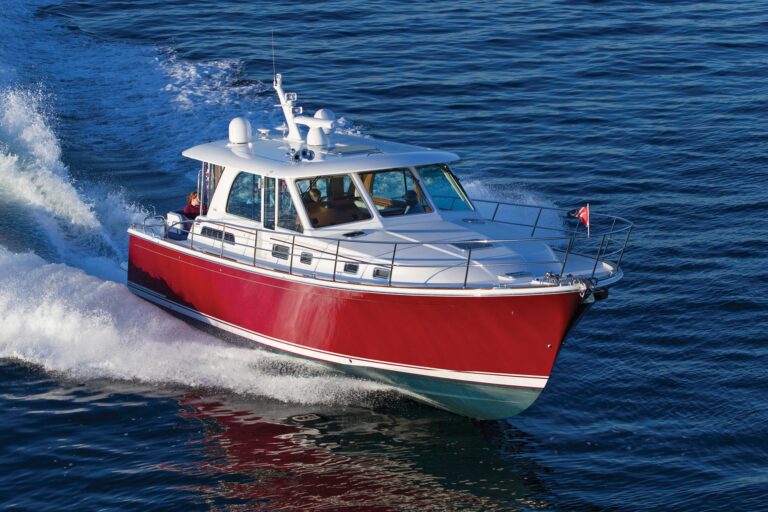Yacht is a word that implies proportionality as well as beauty, so it can be disconcerting to see the helm station of a smaller boat dominated by a huge radar display, especially if the vessel rarely leaves its slip in night or fog.
That’s why when I set out to equip a 37-foot trawler yacht with electronics, I tested Simrad’s smallest radar, the RA30 series, alongside the company’s smallest chart plotter, the CE33. The Norwegian electronics maker touts the RA30C/31C as a compact, yet highly effective radar that will serve equally well on a vessel where space is at a premium or as a second radar for larger yachts. My test lasted eight months in a variety of conditions as I readied the boat, Semper Fi, for a campaign that would include several Intracoastal Waterway trips, a Bahamas cruise and an 870-mile ocean passage from Florida to Bermuda.
From the beginning, Simrad earned high marks for the unit’s ease of installation. I happened to bracket-mount the display, but for owners wanting to flush mount the RA30C/31C, Simrad has a couple of nifty tricks. For $20, customers can buy a kit of product cutouts that will cling to a mounting surface, making straightforward work of planning an instrument console (Cross Currents, December 2002). Second, removable corner pieces allow an installer to screw the display into a dash panel without having to get a hand behind the panel to secure a nut.
The RA30C and RA31C display consists of a 7.4-inch diagonal TFT color screen, 18 push-button keys, a rotary knob and a touch pad for cursor control. The difference between the two designations is the antenna. The RA30C specifies an 18-inch-wide, 2kW scanner; the RA31C, a 24-inch 4kW. In terms of performance, the RA31C has the greater range, promising to return echoes from up to 36 nautical miles away.
I tested the RA31C (ignore that the photos show the RA30C designation on the display; it’s the antenna that accounts for performance). Sure enough, it was at 36 miles that we first “saw the outline of Bermuda. The narrower a radar’s beam width, the better. With its 3.9-degree horizontal beam, the RA31C’s target discrimination proved excellent in a variety of settings and weather conditions.
I found the radar’s three auto-adjustment settings helpful to compensate for sea and rain clutter under routine conditions. Although boating wisdom tells us that the ICW should not be navigated at night, my schedule didn’t often allow the luxury of watching the sun set at anchor. The HBR setting, for close-in use in navigating narrow channels and island-strewn areas with high echo returns, proved an excellent tool one moonless night as I steered Semper Fi from day mark to day mark. For offshore work, I shifted to AT2, which automatically compensates by reducing sea clutter.
The RA30C’s guard zones are also useful, particularly when cruising short-handed. When a guard zone is set-and it can be adjusted to cover a single quadrant instead of an entire 360 degrees-an audible alarm alerts the crew when vessels enter the zone. Problem is the unit’s buzzer is barely audible; plan to plug in an external speaker if this is a feature you expect to use.
Integrating a heading sensor enables the unit’s ATA function, which can be highly useful for night work in high-traffic areas. ATA lets the operator tag up to 10 targets. The radar then presents a menu of information for each tagged target, including distance, bearing, speed and point of closest approach.
As one would expect with today’s radar, the user may choose a variety of display modes, including north up, course up and true motion. These options require that the RA30 be connected to an NMEA-enabled GPS. Integration with a GPS/chart plotter also allows the display of a host of navigational information such as the vessel’s position, speed and heading. This could come in handy if, for example, the RA30C were mounted on a flying bridge away from the vessel’s chart plotter or a repeater. The display is well suited for open air because of its rugged, watertight casing.
The echo tracking feature lets the user observe the relative motion of other boats by displaying a trail whose duration can be chosen in increments from 15 seconds to 6 minutes, or can be displayed continuously.
Simrad has earned high praise for the daylight clarity of its SunView displays, and although the RA30C is not part of the SunView line, its screen clarity was adequate for daytime viewing in Semper Fi’s bright deckhouse. Dimming the screen at dusk was easy using the brill key and adjustment knob, and display colors can be reversed for ease of nighttime viewing.
Unfortunately, our adjacent Simrad plotter did not come with an adjustment knob and employed an entirely different dimming and re-coloring procedure. Simrad would be kinder to its customers by standardizing similar functions across its range of products. The company is proud of its strides in this direction, but needs to go further.
User friendly is an overused phrase. It’s not that Simrad’s RA30C/31C isn’t user friendly, it’s just that learning to use it is somewhat more difficult than with some other marine products. I attribute this learning curve-a better term-to Simrad’s heritage as a manufacturer of military and commercial marine electronics, with an emphasis on ruggedness and longevity instead of whizzy user interfacing. Truth be told, the learning curve is probably overemphasized in reviews such as this one because the reviewers inhabit the learning curve more than actual consumers, who figure out what they think they need and ignore the rest.
Like most other marine electronics manufacturers-Raymarine excepted-Simrad needs to improve its user manuals, at least the RA30C’s. As an example of the manual’s shortfalls, the section called “Reversing the Picture is labeled “day/night feature on the display itself. This is the kind of manual writing that has made “For Dummies books so enormously popular. The RA30C/31C is made by the Japanese company Koden to Simrad specs, prompting one wag to quip that the manual had probably been written in Japanese, translated into Norwegian, and then from Norwegian into English.
Simrad USA product manager Brian Vlad assured me the manual never went through a Norwegian iteration, but admitted improvements were needed. “Believe it or not, it’s a far cry better than what we produced a few years ago, he said. “We are still working on it.
Vlad acknowledged that Simrad’s competitors have begun to substitute simple language for radar’s traditional technical acronyms and that Simrad, too, needs to improve its “human-machine interface. Dumbing down radar, he said, isn’t easy for a company such as Simrad, which has made a reputation building “professional products for professional people. Moreover, he said, small units such as the RA30C are often used as backup units on commercial vessels whose skippers expect them to function like their primary electronics, acronyms and all.
Because of the learning curve, I wouldn’t recommend installing the RA30C/31C in a boat that gets little use. But, this rugged, feature-rich system will provide years of safe, easy navigation for an active skipper who prefers to look at the view instead of another big screen. Again, for larger yachts, this would also provide excellent backup.
Price: RA30C, $2,695; RA31C, $3,495; RA32C/3 (3-foot open array antenna), $4,895; RA32C/4 (4-foot open array antenna) $5,095.
Contact: Simrad, (425) 778-8821; www.simrad-yachting.us
Click here to buy Simrad products.









